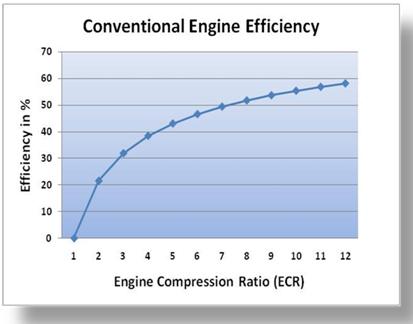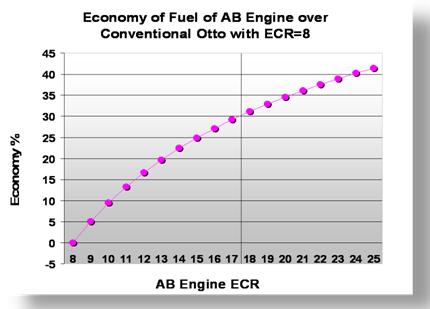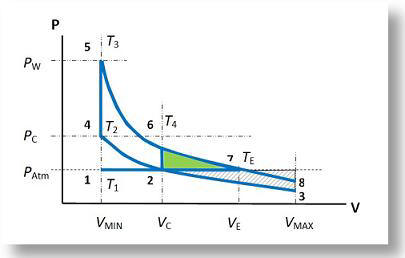|
Technology Presentation |
|||||
|
Fuel efficiency of Conventional and AB Engines
Thermal efficiency of a conventional engine is described by the well know formula:
Where r is an engine compression ratio and k is a coefficient which is typically 1.35.
The graph above shows an example of calculated fuel efficiency for conventional gasoline engine cars or electric generators that use gasoline fuel with octane ratios of 87, 89 or 93. Usually the design of these engines has a compression-expansion ratio in the range of 8 -12. A compression ratio of 8 is typically used for generators and cars that can use any gasoline 87 – 93. In this case, please note that using gasoline higher than 87 has no meaning from an fuel efficiency point of view. Use of high octane ratio fuels only has meaning in luxury cars that build higher compression ratio engines such as those with an r up to 12 The formula below, derived by the AB engine inventor (see description of USPTO Patent application # 20080300772) calculates the AB Engine fuel efficiency which takes into account different compression rE and expansion rC ratios. This formula is accurate for any ICE with different compression and expansion ratios (such as an Atkinson Engine).
|
The graph above shows how much an AB Engine can improve fuel efficiency in comparison to a conventional engine with r = 8
The graph above shows the thermodynamic reason for the difference between conventional and AB Engine fuel efficiency. The area 2-4-5-6 shows the mechanical energy generated by a conventional engine working cycle. Area 2-4-6-7-2 shows the mechanical energy generated by the AB Engine working cycle which includes the area of a conventional engine 2-4-5-6. The green area 2-6-7 is the “extra energy” generated by the AB Engine from the same amount of gas-fuel mixture. We can see from the illustration above that the pressure and temperature of the exhaust gases in the AB Engine are much lower than in a conventional engine; better utilizing heat energy from fuels, lowering gas emissions and exhaust gas temperatures, spending less fuel per mile in cars and per kWT in generators, and keeping our planet cleaner and greener.
|
||||
|
|||||
|
|
|||||



